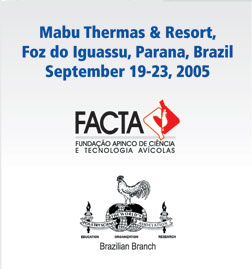Use of avian immunoglobulins in the control of coccidiosis
Morales1, GA., García1, LD.,
Rodríguez1, RA., Lucio1 DE.
1 Investigación Aplicada S.A. de C.V.
Tehuacán Puebla, México
Coccidiosis
research should be directed towards the control of
the parasites through immunological methods, including
the generation of new vaccines or other methods with
special emphasis in avoiding detrimental lesions,
in diminishing time to develop an effective immune
response as well as in avoiding the drug-resistance
problem derived from chemotherapy. Transfer of humoral
immunity from hyperimmunized hens to susceptible chicken
may be an attractive alternative. The aim of the present
research was to demonstrate the usefulness of avian
immunoglobulins in the control of coccidiosis.
MATERIAL AND METHODS: Two ml of specific liquid immunoglobulins
against Eimeria spp. obtained from egg yolks of hyperimmunized
SPF hens were administered by oral route to thirty
chickens (2 groups of 15 each). A second group of
thirty birds received the immunoglobulins in a dry
form at a dose of 100g/T of feed, and a control group
of thirty birds received food without any anticoccidial
drug plus placebo. The treatments were administered
during two weeks before challenge with 150,000 oocysts
of E acervulina and E maxima by oral route. The treatments
continued for one more week and the birds were sacrificed
and submitted to necropsy. Weight gain , feed conversion,
oocyst count in the gut, and lesion scores were determined.
Birds were housed under controlled conditions along
the whole assay.
RESULTS: The weight gain during the last week was
of 273 and 220 g for the group which received immunoglobulins
in the feed, whereas the group of liquid immunoglobulins
had 281 and 310 g and the control group 193 g . Feed
conversion was of 1.82 and 1.85 for the birds that
received liquid treatment as compared with 1.66 and
1.74 in the feed plus immunoglobulins group. The control
group showed feed conversion of 1.98. The average
lesion score was 1.67 and 1.87 in the liquid treatment
group, 2.06 and 2.13 in the feed plus immunoglobulin
group and 2.8 in the control group. In both treated
groups, a 126,000 oocyst count was recorded as compared
to 192,000 oocysts in the control group.
DISCUSSION The liquid treatment group showed the best
performance in weight gain as compared to feed plus
immunoglobulin and control groups. Lesion scores of
the liquid treatment and the feed plus immunoglobulin
groups were lower as compared with the control group.
A significant reduction (66%) in oocyst production
was observed in the treated groups as compared to
the control group. The specific antibodies against
coccidia provided effective protection decreasing
intestinal damage and oocyst production. Antibody
therapy may be an innocuous tool in the control of
coccidiosis in birds.
